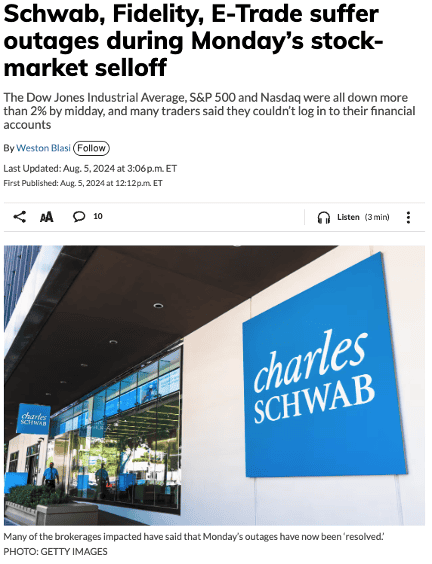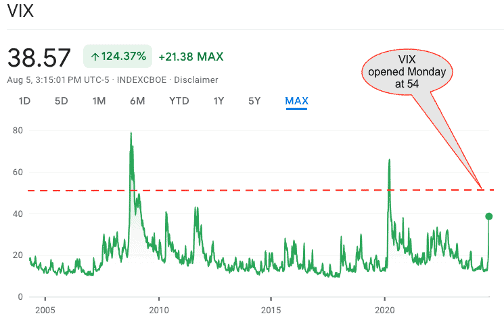If there’s one thing we learned from yesterday, it is that your money is not safe. You wake up one day and poof, the market sells off huge, triggered by some weird stuff in Japan. At the same time, CNBC’s Jim Cramer continues to tirelessly push a bullish thesis on anything that moves. And, Wall Street pundits unabashedly reinforce the message that everything is fine: “We’re your trusted source for navigating the markets.”
How many of you got an email from Seeking Alpha with the subject: “Markets are down – we’ve got you covered”? Right, sure. Those messages are little consolation for the unexpected losses in your portfolio. It’s like these firms forgot they were bullish a few days ago, and you shouldn’t be surprised by their bearish take today.
There is no honor among thieves. If you think I’m coming on too strong, bear with me for just a minute. I am going to share with you the best, quickest tutorial on Wall Street. Then, I am going to explain what sparked the big sell off the last few days
First, I need to be sure you have the right context for what’s happening these days. I promise to keep it short and sweet with a movie clip that is worth a million words. I will also, as usual, provide several specific stock ideas. But, I will not pretend that I have all the answers.
Wall Street firms and advisors like to make you think everything is taken care of. They’ve done the work. Their ratings are reliable. They’ve done their diligence and scrubbed the numbers. And, they keep telling us that we can trust them even though time and again, we learn that we can’t. This scene from the movie The Big Short is one of my favorites of all time because it so perfectly shows why you cannot trust Wall Street. If you’ve not watched this 87-second clip before, you are in for a treat. And, you better be sitting down.
Figure 1: Steve Eisman Gets S&P To Admit They Do Not Do Diligence
Sources: YouTube
This scene is the most important in the movie because it shows exactly how Wall Street plays the game of acting like they’ve done real research when they’re really just trying to make money off you.
Then, all of a sudden, you wake up one morning and the sh-t has hit the fan…and everyone is looking around all surprised because they could never have seen it coming. It’s a strong con.
And, this clip from The Big Short shows you exactly how they play it and why. It shows the representative from Standard & Poor’s trying to pretend her firm has done the work she knows they are supposed to do but have not. After being pressed (quite gently I would say) about how her firm could’ve done the proper research and come to the conclusion that the bonds deserved good ratings, she admits that they had to give out good ratings because that’s what everyone else did. She admits they overlooked the truth, gave out misleading ratings for the money because if they did not, they would lose money because the companies would just “go down the street” and get the good ratings from someone else. This is a movie clip, but it is based on real life.
Another real-life fact: Wall Street does not want you to know valuation matters. Because if you know that valuation matters, then you are less likely to take the terrible risks they’re selling they can profit from your trades.
Wall Street makes money, rating agencies make $ – even when you lose. The financial crisis happened because they did not do their homework despite putting on appearances that they did. The worst part is that they were never accountable for the damage they did.
If you do not believe me, check this out:
- In S&P amazingly says no one should believe its ratings are independent and objective, we learn that S&P’s defense for the misleading ratings is “no one should’ve believed us anyway”. So, they admit the ratings were bad, and their defense is that no one should’ve believed them anyway.
- This wikipedia post on Explanations for inaccurate ratings has more gory details on all the reasons the ratings were unreliable. In other words, it’s now fact that the ratings were bad.
The point is: yes, you’ve seen this movie before. The question is: how many more times do you need to see it before you stop falling for it?
Meanwhile, yesterday, the big Wall Street players were busy selling on one of the most volatile days for the stock market in many years, and millions of main street investors were locked out of their accounts.
Figure 2: Who Is Allowed To Sell?
Sources: MarketWatch
If you don’t think Wall Street is stacking the deck against you now, I give up. Just kidding, I will never give up my mission to improve the integrity of the capital markets. Ask anyone who has known me the last 20+ years since I founded New Constructs.
My point is that the evidence supporting the idea that you need to do your own diligence and not assume Wall Street investment banks or ratings agencies are doing it for you is quite adequate.
What is the Yen Carry Trade?
Now, let’s talk about what kicked off this market mess. Many of you may have heard the phrase “yen carry trade” recently. Put simply, this means big hedge funds and Wall Street players were selling and/or shorting the Japanese yen as a means to raise cash that they could, in turn, invest in stocks. For the most part, the stocks that got this investment were the “Magnificent 7” stocks everyone has been talking about as crowded trades for many a long time now: NVDA, AMZN, TSLA, etc.
This trade worked great for so many Wall Street insiders because the cost of borrowing yen was super cheap, like 1-2%. As long as the stocks funded by the yen borrowings went up more than 1-2% per year, the trade worked. The money borrowed to fund investing cost 1-2% while the return on funds invested was greater than 2%. The Japanese yen has been so cheap for so long and the trade worked for so long that Wall Street insiders got to thinking the good times might never end. Does that mentality remind you of anything? Like the idea that house prices could never decline: the widely-held belief before the housing market crisis and the reasoning behind taking highly inappropriate levels of risk that blew up the entire financial system.
Why Is the Yen Carry Trade A Big Deal?
In isolation, the unwinding of the yen carry trade might not have been a very big deal. The reason it is a big deal now is that this unwinding is happening in a market already propped up by unprecedented amounts of fiscal and monetary stimulus – as I detailed a few days ago in my letter The Trump Trade That No One Is Talking About. The combination of so much excess liquidity in the markets and so much capital concentrated[1] in a few mega cap positions remains a recipe for disaster. As we have often explained in our Zombie Stock reports, each successive new high by the markets felt like stacking more cards on a precariously tall house of cards.
And, as anyone who’s built a house of cards knows, it only takes removing one well-placed card to bring the whole house crumbling down. That’s what’s happening now with the unwinding of the yen carry trade and overly crowded trading in the “Magnificent 7”.
Figure 3: VIX Nearing Historic Highs
Sources: Source: Google Finance & New Constructs
Note that the VIX opened Monday morning (August 5th, 2024) at over 50, the highest level since the Great Financial and COVID-19 crises. Typically, and as the chart suggests, statistically significant increases in the VIX tend to last for a while. In other words, the fun is not over.
Add in the fact that the liquidity from the yen carry trade is likely lost from the market for the foreseeable future, and I think it is fair to expect more selling. Lots of big hedge funds need to raise cash to cover their yen shorts, and many of them are selling the same stocks at the same times (crowded trades), which causes more selling. And, a vicious cycle is likely to ensue.
Valuation is going to start mattering a lot more.
So, what do you do now?
We’ve established that:
- Wall Street can’t be trusted to do real diligence
- Valuation matters now.
So, the first thing to do is find stock research you can trust. Either your own or someone else’s. It is time to sharpen your pencils or find someone whom you can trust to do real work.
We think we fit that bill. The reason I’ve given away so many free picks over the last several months is so you would know what good research looks like. And, when you went looking for more of it, you would:
- Not be fooled by the fake news/research out there and
- Know where to find us.
I have some specific recommendations today too.
- Make sure you do not own any of the stocks on our Zombie Stock list (free here for our readers) or in our Most Dangerous Stocks and Focus List: Short Model Portfolios (not free and worth every penny). For example, here’s how much damage over just the last 30 days through yesterday that investors could have avoided if they kept up with our Zombie Stock picks:
- Snap (SNAP): down 47%% and down 40% more than the S&P 500Robinhood (HOOD): down 27% and down 20% more than the S&P 500
- Beyond Meat (BYND): down 26% and down 17% more than the S&P 500
- And, if you’re going to be in any stocks at all, I think the best stocks to get through the coming storm are in our Focus List Stocks: Long and Most Attractive Stocks Model Portfolios. Also, be sure to check our featured Long Ideas. These are the stocks picks, by the way, that largely drive our #1 rankings for stock picking for 38 consecutive months on Sum Zero.
- Join my next training, “Get the best, new “Hidden Gems” for a Volatile Market Based on Our Superior Analysis of Q2 Earnings” on August 15th at 5pmET. Register here.
We want you to know how much work we do!
As always, we are 100% transparent in all of our research, reports, ratings, and models. We regularly review our work and research on Long Ideas and Danger Zone Ideas with clients. We want you to know how much work we do! Here’s how we share our work:
- Free live Podcast every month. The next one is on Friday, August 9th, register here.
- Join our online community (use this form to sign up for free) and ask questions and make requests anytime! Get free replays of prior podcasts. Lots of smart investors talking to each other is a good thing.
- Monthly Let’s Talk Long Ideas webinars where we do deep dives into our research, analytics, reverse DCF models and ideas for our Professional and Institutional clients. Our next one is on August 14th at 5:00pmET. Replays are here for our Professional and Institutional clients.
If this message resonated with you and you want to start your investing future with us – schedule a meeting with us here.
Diligence matters,
David
This article was originally published on August 6, 2024.
Disclosure: David Trainer, Kyle Guske II, and Hakan Salt, receive no compensation to write about any specific stock, sector, style, or theme.
Questions on this report or others? Join our online community and connect with us directly.
[1] “Underscoring just how concentrated some of the most popular trades had become, Deutsche Bank analysts wrote last week that hedge funds and other “smart-money” investors’ positioning in tech stocks and shares of other fast-growing companies was at the 97th percentile of historical norm.” – from The Wall Street Journal: 2024’s Most Popular Trades Are Unraveling



